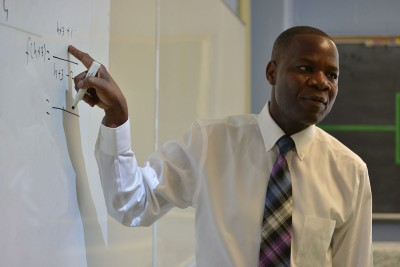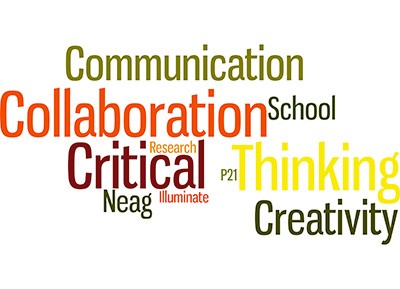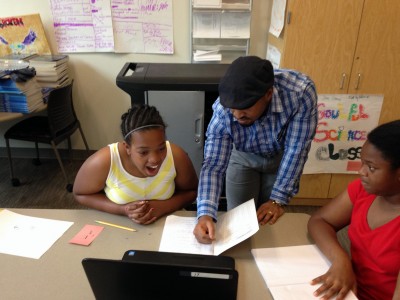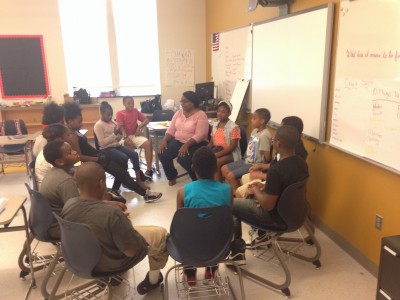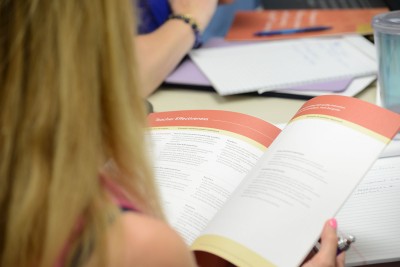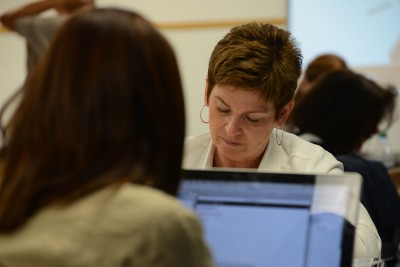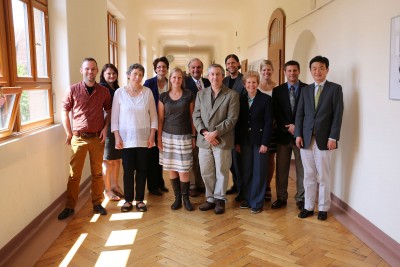Below are news and notes from our alumni, faculty, staff, and students. We are proud of all the amazing accomplishments by our Neag family. If you have an accolade to share, we want to hear from you! Please send any news items (and story ideas) to neag-communications@uconn.edu
Alumni
Kerri (Haynes) Adakonis `88 (ED) was appointed assistant principal of Schaghticoke Middle School in New Milford, Conn. Previously she was the administrative intern at Sarah Noble Intermediate School in New Milford where she was involved with student placement and scheduling, discipline, special education, and planning of special school events. Prior to coming to New Milford, she worked in the Fairfield Public Schools as a fourth and fifth grade teacher and the district’s instructional improvement teacher.
Edward Boynton Jr. `11 (ED), `12 MA married Kayleigh MacRae in Plymouth, Mass., in June. They met at the University of Connecticut. Boynton is a special education math teacher in Massachusetts.
Jay P. Cahalan `88 MA was appointed president and chief executive officer of Columbia Memorial Health, of Hudson, N.Y., and worked with the hospital for the past 20 years in several executive positions. Previously, he worked for Windham Community Memorial Hospital in Willimantic, Conn., and was also president and part owner of Hudson Health & Fitness in Hudson. Cahalan has been a member of The Bank of Greene County’s advisory board of directors since 2012. Cahalan is president of the Greene County Rural Health Network, and serves on the boards of the Iroquois Healthcare Alliance, United Iroquois Shared Services, and the United Iroquois Select.
Shelbi Cole `02 (ED), `03 MA, `11 Ph.D. visited the UConn campus in May, along with educators from the across the country, to write and refine test questions to enhance Smarter Balanced assessments. Seventy educators, including instructional coaches, national experts, teachers, and preservice teachers representing 13 states, worked collaboratively first at UCLA, and then UConn. Cole is the deputy director of content for Smarter Balanced.
John Cormier `88, `91 MA, `93 6th Year was named Teacher of the Year for the Norwich School District in Norwich, Conn. He is a school psychologist at Griswold High School and was the fifth non-classroom educator the district has selected for the honor. A large part of his job involves assessing students with learning disabilities and consulting with his teachers to develop learning plans tailored to help them succeed.
Brian Jehning `06 (ED), `07 MA was selected as Region 15’s Teacher of the Year. He teaches science at Pomperaug High School, which serves students in the towns of Middlebury and Southbury, Conn. He is also a site director for athletic games and announces football games. Jehning has been a teacher at the school for seven years.
Stephen Kilgus `06, `07 MA, `11 6th Year, `11 Ph.D. won Article of the Year from the Journal of School Psychology. He was recognized at the Society of School Psychology’s annual meeting in August.
Eleanor Lee `78 MA, `83 6th Year is a real estate agent at Hammond Realty in Hartford, Conn. Lee was an educator and administrator with the South Windsor school system for 24 years, including 13 years as principal of Eli Terry Elementary School. Prior to working for South Windsor schools, she was an early childhood and special education teacher. Early in her career, Lee founded and managed Stepping Stones Early Learning Center in Enfield. Most recently, she worked as a job coach for the Connecticut Bureau of Rehabilitative Services.
Jason Lehmann `08 MA was named middle school principal at East Hampton Middle School in Hampton, Conn. Lehmann has been assistant principal at the middle school for the past four years.
Kimberly Loveland `12 6th Year was hired as principal of Waddell School in Manchester, Conn. For the past two years, Loveland was the supervisor of mathematics in the Suffield school district. Before that, she was a math teacher in the Glastonbury school district.
Kelly M. Lyman `88 MA, `01 6th Year was appointed school superintendent of Mansfield Schools, in Mansfield, Conn. Lyman, of West Simsbury, was previously the assistant superintendent of Regional School District 15, serving Southbury and Middlebury. She also has served as a lead professor of practice in the Neag School’s educational leadership program, as an administrator-in-residence for the Connecticut State Department of Education, and as a director of studies for an alternative education experience conducted in partnership with UConn and the Hartford Public Schools.
Rachel McAnallen `11 Ph.D. has co-written Awesome Alex, Math Detective (48 Hour Books, 2015). Known simply as “Ms. Math” to children across the country, McAnallen has devoted her life to sharing the joy and beauty of mathematics with learners of all ages. A lifelong learner, she approaches the world around her with a boundless curiosity and a playful sense of humor that is reflected in her teaching style. The book is about a precocious fifth-grade math detective embarking on a guided number mystery. McAnallen has been a faculty member with Confratute for a number of years and teaches at the Renzulli Academy in Hartford, Conn.
Jennifer Miller `15 6th Year has been hired as principal for the Prudence Crandall School in Enfield, Conn. Miller most recently was a resident principal at Maple Street School in Vernon and also has experience as an instructional coach in numeracy and literacy, and was a fifth- and second-grade teacher.
Christina Nadeau ’13 (ED), ’14 MA, is the high school music teacher at New London High School in New London, Conn., where she teaches band, chorus, percussion, and general music.
Diana Payne `07 Ph.D. was presented with the Dr. Sigmund Abeles Science Advocate Award at the annual Connecticut Science Teachers Association (CSTA) and Connecticut Science Supervisors Association (CSSA) awards banquet in May at the New Haven Lawn Club in New Haven, Conn. Payne was also recognized for her regional, national, and international service. She is the regional co-coordinator of the Quahog Bowl (CT-RI regional of the National Ocean Sciences Bowl) and has been involved in aquatic invasive species programs with Sea Grant colleagues nationally. Most recently, she was named a Fulbright Scholar and will spend part of the fall of 2015 in Denmark.
Amy H. (Jackson) Reising `91 MA was appointed deputy director of the California Commission on Teacher Credentialing. Reising has been the director of credentialing and teacher development at High Tech High in San Diego since 2008. She was deputy director at the National Comprehensive Center for Teacher Quality from 2006 to 2008 and worked at the California Commission on Teacher Credentialing as an administrator for examinations, research, and teacher development from 1998 to 2006. She was project manager and consultant at Educational Testing Service from 1997 to 1998 and a research consultant at WestEd from 1990 to 1997.
Kaitlin Roig-DeBellis `05 (ED), `06 MA is the author of Choosing Hope (G.P. Putnam’s Sons, 2015) and will be participating with a book tour starting in October, including one at the UConn Co-op bookstore in Storrs. She is the founder and executive director of Class 4 Classes, which recently received a $27,500 grant from Unite4Good.
Ken Roy, `81 6th Year, `85 Ph.D., a 1989 Milken Award Recipient, director of Environmental Health & Safety for Glastonbury, Conn., and chief science safety compliance advisor for the National Science Teachers Association, was recently awarded the Prakken Professional Cooperation Award at the 77th annual International Technology and Engineering Educators Association (ITEEA) conference in Milwaukee, Wis. The award recognized his tireless efforts to help ITEEA and NSTA collaborate in ensuring safer STEM education laboratory practices. He co-authored a book on laboratory safety for ITEEA in 2014 and has also published and presented on technology and engineering education safety to help address the recently released Next Generation Science Standards.
Maureen Ruby `77 (ED) was appointed as assistant superintendent for Brookfield Public Schools in Brookfield, Conn. Most recently, she was the director of personnel services at Norwalk Public Schools. Before joining the central office in Norwalk, Ruby was the supervisor of professional development and career management for New London Public Schools. She started her career as an elementary school teacher in North Branford where she was named the District Teacher of the Year. After teaching, she became a literacy facilitator for several grant initiatives and is also a professor at Eastern Connecticut State University.
Matthew J. Salvestrini `03 6th Year is director of digital learning at New Canaan Public Schools in New Canaan, Conn. For the past six years, Salvestrini has served as principal at Gainfield Elementary School in Regional School District 15 for Southbury and Middlebury. While at Gainfield, he successfully implemented a program to upgrade the school’s instructional technology, resulting in the availability of SMART Boards, document cameras, and iPads in all classrooms. Salvestrini has served as an elementary assistant principal in both Brookfield and Darien, and has taught at the elementary and high school levels.
Lois Greene Stone `55 and her husband, Dr. Gerald E. Stone, MD, recently celebrated their 59th wedding anniversary. They have 15 grandchildren and two great-grandchildren. Stone is a writer and poet, and has been syndicated worldwide, with her poetry and personal essays having been included in hard and softcover book anthologies. Collections of her personal items, photos, and memorabilia are in major museums, including 12 different divisions of The Smithsonian.
Martin Summa `12 (ED), as a member of the University of Maryland’s digital marketing and social media unit, was named one of three finalists for the 2015 Marketing Team of the Year Award (MTOYA), presented by SuperFanU.
Carole Swift `14 Executive Leadership Program was named director of special education for Milford Public Schools in Milford, Conn. Swift has been an educator for more than 25 years. Her career in special education began in 1992 at Benhaven School, a private school in Wallingford, Conn., for children with autism. In 1998, Swift was hired in Milford as a special education teacher at Pumpkin Delight Elementary School. Eight years later, she was asked to serve as a special education teacher leader for the middle schools and as a K-12 special education reading coach. In 2010, Swift was appointed principal of Orange Avenue School, where she served for five years, working with staff and families to create a culture wherein every child is embraced.
Katie Uriano `15 6th Year was named principal of Hebron Elementary School in Hebron, Conn. Most recently, she was a staff member at Gilead Hill Elementary. Uriano has spent her teaching career of more than a decade in Hebron. She has taught first and second grades, served as head teacher, and most recently was employed as the school math specialist, developing best practices for the instruction of mathematics and providing professional development for teachers. At Hebron Elementary, Uriano has also been a master mentor, a coach for the positive behavioral intervention and support program, and the director of the summer school.
Joshua Wilson `14 Ph.D. was appointed an assistant professor of special education at the University of Delaware’s School of Education. He has continued research work that he started during his doctoral program with his advisor, Natalie Olinghouse, which most recently appeared in the University of Delaware’s UDaily.
Mary Yakimowski `82 MA, `84 6th Year, `86 Ph.D. was named assistant dean for assessment at Sacred Heart University’s Isabelle Farrington College of Education (FCE). In this new role, Yakimowski will provide leadership in the development, implementation, and administration of a comprehensive assessment system for FCE students and programs. Most recently, she served as an assistant professor within the FCE’s Department of Educational Leadership and Literacy. Before arriving at FCE, she was an associate professor-in-residence for nine years at the Neag School of Education, serving as director of assessment. In her nearly 30 years in education, Yakimowski has worked in urban pre-K-12 public schools in Connecticut, Virginia and Maryland, served as an adjunct at UConn, Virginia Tech and Johns Hopkins and worked for the Connecticut Department of Education and Council of Chief School Officials.
Faculty
Erica Fernández and Tutita Casa were recipients of the UConn Office of the Vice President for Research’s Scholarship Facilitation Fund (SFF) Awards for Fall 2015. The SFF is designed to assist faculty in the initiation, completion, or advancement of research projects, scholarly activities, creative works, or interdisciplinary initiatives that are critical to advancing the faculty member’s scholarship and/or creative projects.
Preston Green will serve as a panelist for The Connecticut Mirror’s second statewide public policy event, “Small State, Big Debate: Race,” in October at Fairfield University as well as an invited speaker at the Northeastern Educational Research Association Conference in October in Trumbull, Conn., where he will talk about the legal status of charter schools. Green is the co-author of forthcoming book Censorship and Student Communication in Online and Offline Settings (IGI Global, 2015), a reference source that addresses the issues surrounding students’ right to free speech in on- and off-campus settings. He also co-wrote a commentary that was published in the West’s Education Law Reporter advance sheet.
Jae-Eun Joo served as the co-guest editor of The Curriculum Journal special issue titled “Innovation in Learning and Teaching Toward the New Global Village: International Perspectives on Transforming Curriculum with Emerging Technologies.” The special issue offers a comprehensive international picture of new online learning and teaching and contains studies about digital literacy in New Zealand; an online game-based learning in Hong Kong; an African dance class in New York City; an NSF project with students from Greenland, Denmark, and the U.S.; and Scott Brown’s GlobalEd Project.
James Kaufman and his wife, Allison B. Kaufman, recently published Animal Creativity and Innovation (Academic Press, 2015). The book is a comprehensive review of what we know about animal creativity and how research findings inform our understanding of human creativity.
Bianca Montrosse-Moorhead was selected to attend EvalPartners Global Evaluation Week to be held in Nepal in November, where she participating in at least three different ways. First, she has just been appointed to the steering committee of EvalYouth, a new EvalPartners global initiative to promote young and emerging evaluators to be leaders in the evaluation field, and she will help to formally launch this initiative. Second, she will help celebrate EvalYear 2015 and attend the global Parliamentarians Forum for Development Evaluation, both sessions to be held in the Parliament of Nepal. Finally, she will share her expertise on “Building Evaluation Skills in Government” during the Third Conclave of the Community of Evaluators-South Asia, which will be held in conjunction with the Global Forum.
Jonathan Plucker was recognized by Noodle as one of “67 Influential Educators Who Are Changing the Way We Learn in 2015.” He has also been a participant with the Patent and Trademark Office’s Patents for Humanity program for several years. The work has been widely praised for its dedication to helping humanity through innovative technology. Plucker was also named the Curry School 2015 Distinguished Alumnus by University of Virginia’s Curry School of Education Foundation.
Joseph Renzulli and Ronald Beghetto received a $175,000 grant from the Imagination Institute at the University of Pennsylvania to examine the importance of imagination, creativity, and innovation (ICI) – considered essential qualities for the cultural, social, and economic growth of nations – as vital outcomes of schooling. The study will include the development of a series of validated instruments, a portfolio that documents a school’s outcomes, and a guidebook for schools to develop and extend their ICI resources.
George Sugai spoke during a breakout session at a supportive school discipline daylong conversation at the White House in July. The White House brought together teams of superintendents, principals, and teachers from school districts across the country, as well as stakeholders, researchers, and corporate and philanthropic partners.
Richard Schwab has been an active commissioner with the National Commission on Teaching & America’s Future’s (NCTAF) Great Teaching Initiative. The three-year initiative includes hosting joint convenings around key issues that impact the teaching profession; establishing a collective research agenda; developing tools and strategies to support teachers, both in their classrooms and careers; and building a repository of best practices, case studies, and positive examples of components of great teaching to highlight what is working well in schools.
Suzanne Wilson has been appointed to the new co-editor team of the newly integrated American Educational Research Journal (AERJ). She will serve as a co-editor with faculty members from five other universities for the 2016-2018 volume years.
In Memoriam
Thomas F. Andrews `75
Earnest Bottomley Jr. `51
Hollace P. Brooks `71
John A. Burns `67
Mario A. Campos `58
Elizabeth Q. Corbett `67
Thomas E. Daley `72
Dick Dempsey, faculty emeritus
Thomas G. Dean `53
Ben L. Edwards `70
Ray E. Fabian, Jr. `54
Carolyn R. Falk `86
Joseph G. Gabriele `67
John D. Hogan `54
Rosemary M. Jejer `46
Paul F. Joyce `69
Donald W. King `79
John H. Kivela `74
Michael M. Lavigne `06
Joan M. Lichtenfels `69
Marjorie L. Luce `91
Carol P. Makara `67
Janet H. Mansfield `85
Viola F. Margarones `55
Glenn V. McLellan `59
Anne V. Nolan `67
Marie A. Piccoli `78
Carol A. Shea `64
Esther W. Shoup `76
Joseph F. Spada `60
Robert R. Spillane `67
Marshall H. Tourtellotte `81
Patricia A. Young `73
